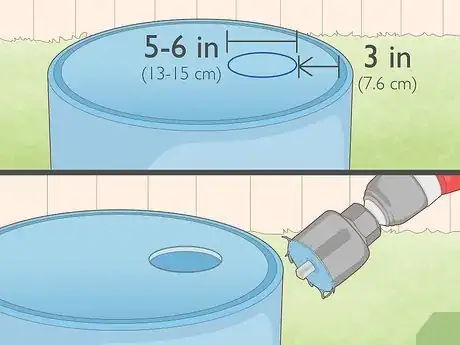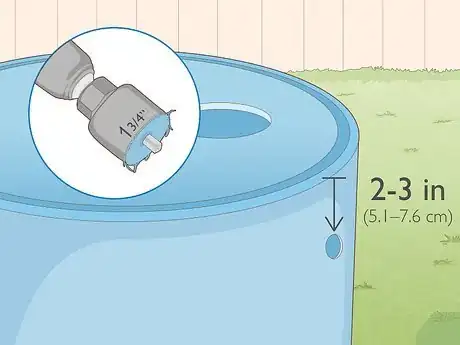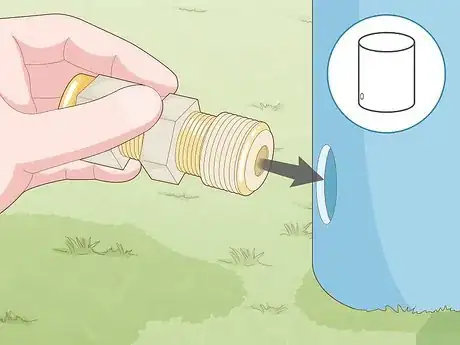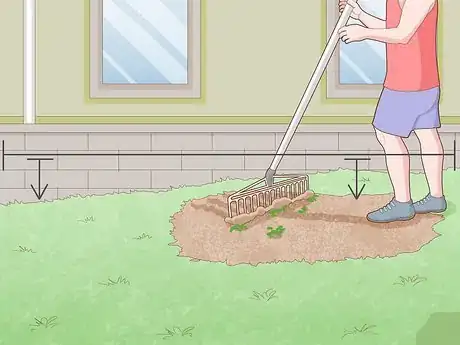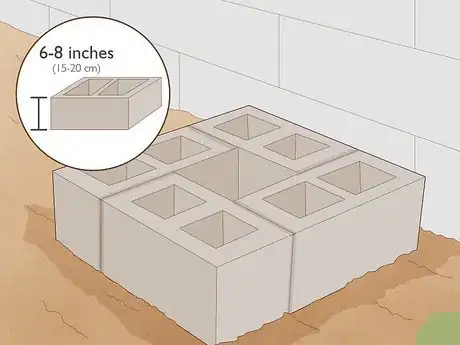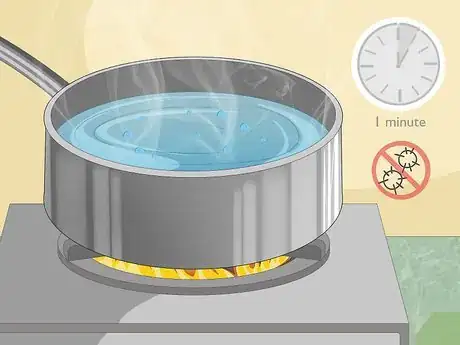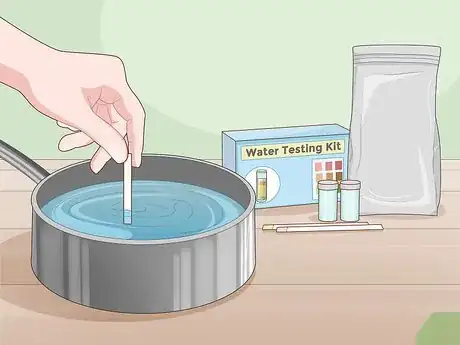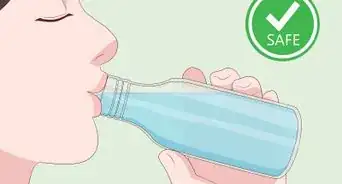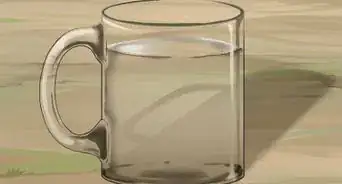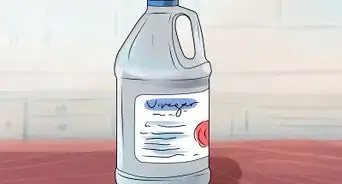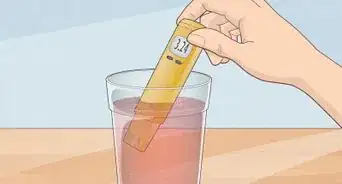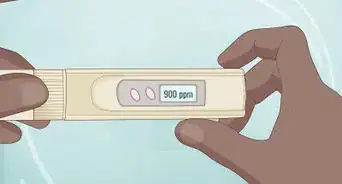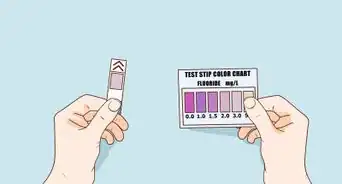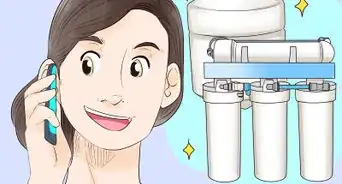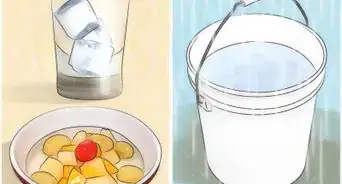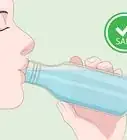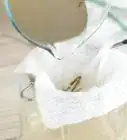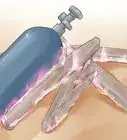This article was co-authored by wikiHow staff writer, Hunter Rising. Hunter Rising is a wikiHow Staff Writer based in Los Angeles. He has more than three years of experience writing for and working with wikiHow. Hunter holds a BFA in Entertainment Design from the University of Wisconsin - Stout and a Minor in English Writing.
There are 19 references cited in this article, which can be found at the bottom of the page.
This article has been viewed 29,101 times.
Learn more...
Collecting rainwater can help you save money on your water bill and conserve resources in an emergency. While you can regularly use it to water plants or clean, there are a few additional safety measures you need to take before you can drink rainwater. To start collecting rainwater, build a rain barrel from a plastic drum to catch the water. Attach the rain barrel to a downspout from your home’s roof along with filter diverters to get rid of some of the contaminants. After you have enough water in the barrel, be sure to filter and disinfect it so it’s potable!
Steps
Making a Rain Barrel
-
1Check with your local government to see if rainwater collection is legal. In some areas or states, you may not collect rainwater unless you have special permits. Reach out to your local environmental quality or health department and ask them if you’re able to collect rainwater on your property. If your state or city requires a permit, ask them about the process of obtaining one and be sure to complete it entirely before building your rain barrel.[1]
- You can find a list of state-specific regulations here: https://www.ncsl.org/research/environment-and-natural-resources/rainwater-harvesting.aspx.
- Some areas that allow rain collection may even offer tax exemptions if you use a rain barrel.
Tip: Keep in mind the average rainfall in your area and how much water you usually drink throughout the day. Usually, if you get more than 24 inches (61 cm) of rain yearly, you’ll be able to use rainwater for most of your drinking water throughout the year.
-
2Cut a 5–6 in (13–15 cm) intake hole in the top of a plastic barrel. Use a dark-colored 55 US gal (210 L) plastic barrel to catch the rainwater. Trace a round template that’s 5–6 inches (13–15 cm) in diameter on top of the barrel so it’s 3 inches (7.6 cm) from the edge. Follow along the traced outline with a reciprocating saw or jigsaw to remove the section from the barrel.[2]
- You can buy plastic barrels from your local hardware store or online.
- Avoid using light-colored or clear barrels since they could let light inside and cause algae to grow in the water.
- Make sure the plastic barrel you’re using is labeled as “food-safe,” or else contaminants could leach into the water from the plastic.
Advertisement -
3Make an overflow hole on the side of the barrel with a hole saw. Attach a 1 3⁄4 inches (4.4 cm) hole saw attachment in a drill and make sure it’s secure. Position the overflow hole on the side of the barrel so it’s 2–3 inches (5.1–7.6 cm) down from the top. Push the hole saw attachment firmly against the side of the barrel and pull the drill’s trigger to cut through the plastic. Pull the saw straight out when you finish the cut to remove the piece.[3]
- The overflow hole will allow excess water to drain out in case it gets too full.
- You can buy hole saw attachments from your local hardware store.
-
4Attach a bulkhead fitting to the overflow hole. Bulkhead fittings are waterproof valves that allow you to connect hoses or faucets to the barrel. Reach inside the intake hole of the barrel with the threaded male end of the bulkhead and feed it through the overflow hole so it pokes out the side. Push the fitting’s rubber washer onto the threading before screwing the circular female end tightly against the barrel.[4]
- You can buy bulkhead fittings from your local hardware store.
-
5Drill the valve hole 2–3 in (5.1–7.6 cm) from the bottom of the barrel. Position the valve hole so it’s on the opposite side of the barrel as the overflow hole and 2–3 inches (5.1–7.6 cm) up from the bottom of the barrel so it can drain most of the water. Press the hole saw attachment against the barrel and apply slight pressure as you pull the trigger. Pull the saw out from the hole and remove the cut section of the barrel.[5]
- Avoid putting the valve hole any higher on the barrel, or else you won’t be able to drain all of the rainwater out.
-
6Seal the threadings on the faucet valve with Teflon tape. Get a faucet valve that has a 1 3⁄4 in (4.4 cm) fitting so it’s able to fit tightly in the hole you just drilled. Place the end of the Teflon tape on the threaded portion of the valve and wrap it clockwise. Go around the threading at least 3–4 times to seal and waterproof them so the rainwater doesn’t leak out of the barrel.[6]
- You can use any type of faucet valve for your rain barrel.
Warning: Avoid wrapping the Teflon tape counterclockwise around the valve since it could come loose when you try to attach it to your barrel.
-
7Screw the faucet valve into the hole on the side of the barrel. Position the threaded end of the faucet valve in the hole you drilled near the bottom of the barrel and turn in counterclockwise. Continue screwing the valve in until the threading goes completely inside the barrel so water doesn’t leak out. Make sure the faucet points down when you’re finished screwing it in, or else it won’t be able to drain properly.[7]
- If the hole is too tight to screw the faucet valve in, scrape the sides of the hole with a file or rasp until it’s large enough for the faucet. Be careful not to make the hole too large or else the faucet won’t fit snugly.
-
8Secure insect netting over the intake hole with caulk. Cut a 7 in × 7 in (18 cm × 18 cm) square piece of insect netting with a pair of scissors so it’s large enough to cover the intake hole. Use a caulk gun to apply a bead of caulk around the edge of the hole and press the insect netting down firmly so it stays in place. Allow the caulk to dry for 20–30 minutes so it has time to set.[8]
- You can buy insect netting from outdoor or home improvement stores.
- Mosquitoes commonly breed and lay eggs in water, so it’s important to keep them out of your water supply.
Installing the Barrel on a Downspout
-
1Level the ground near the downspout where you want your rain barrel. Choose a downspout coming down from a section of your home’s roof that doesn’t have any trees or wires over it. Use a shovel or spade to remove soil or landscaping next to the downspout so it’s perfectly flat so the rain barrel doesn’t tip over when it’s full. Pat the ground with the back of the shovel to help compact it and make it more sturdy.[9]
- You can use any downspout attached to your home’s gutter system.
Variation: If you don’t have a roof with a downspout that you can easily access, look for circular rain saucers that attach to the top of the barrel. Wrap the saucer’s fasteners around the barrel to secure it in place so rainwater drains directly into the barrel.[10]
-
2Place 4 cinder blocks in a square to form a sturdy base. Choose cinder blocks that are about 6–8 inches (15–20 cm) tall so they raise the barrel off of the ground. Arrange the blocks into a square shape that’s large enough to support the bottom of the rain barrel, which usually has a 23 in (58 cm) diameter. Make sure the tops of the cinder blocks are level so the barrel doesn’t tip.[11]
- Cinder blocks also raise the barrel off of the ground so you can fit a container underneath the faucet when you want to empty the barrel.
- You can also set concrete pavers on top of the cinder blocks if you don’t want gaps between them.
-
3Cut a 12 in (30 cm) section out of your downspout with a hacksaw. Start your first cut so it’s about 1 foot (30 cm) above the top the rain barrel so the water can drain down easily. Hold your hacksaw perpendicular to the downspout and apply firm pressure as you cut through it. Make the next cut 12 inches (30 cm) higher than the first one and discard the cutout section when you’re finished.[12]
- Use a step ladder if you aren’t able to reach the section you need to cut out.
-
4Install a rain filter diverter onto the cut sections of the downspout. A rain filter diverter looks like a curved section of downspout has a grated mesh that captures leaves and solid debris and allows water to flow through it. Push the top hole of the rain filter diverter onto the upper portion of the downspout so it’s tightly secured. Carefully position the lower portion of the downspout into the hole at the bottom of the diverter and push it in.[13]
- You can buy rain filter diverters online or from your local outdoor care store.
- You do not need to screw or fasten the rain filter diverter to the downspout since it will have a snug fit.
-
5Attach a first-flush diverter to the side of the rain filter. A first flush diverter captures the first 5–10 gallons (19–38 L) of rainwater in a drainage tube to remove debris or contaminants that wash off your roof so it doesn’t get into your rain barrel. Position the intake end of the kit onto the hole on the side of the rain filter diverter so it fits snugly. Attach the vertical tube with the ball onto the bottom of the diverter’s intake tube so the drain is on the bottom.[14]
- You can buy a first-flush diverter kit online or from outdoor care stores for about $50 USD.
- Don’t attach a rain barrel to the downspout without a first flush diverter, or else you could contaminate the water with bird poop, dust, or leaves.
- As rainwater flows through the first-flush diverter, it will fill the vertical tube and cause the ball to float to the top. Once the vertical tube fills, the ball will create a seal and allow the cleaner water to go into the rain barrel.
-
6Position the end of the first-flush diverter over the intake hole on the barrel. The last section of the first-flush diverter has a flexible tube so you can bend and position it. Place the end of the flexible tube against the insect netting on the barrels intake hole so the rainwater can drain into the barrel. You do not need to screw or fasten the tube since it will stay in place on its own.[15]
-
7Connect a garden hose to the bulkhead on the overflow hole. Don’t leave the overflow hole exposed since bugs could easily fly into the rain barrel and breed in the water. Screw a 4–5 ft (120–150 cm) garden hose onto the bulkhead fitting in the overflow hole and place the other end on the ground so it points away from your home’s foundation.[16]
- If you’re worried about bugs going up through the hose, you may secure insect netting to the end of the hose.
Filtering the Rainwater
-
1Use the rain barrel’s faucet to drain the water into a container. Position a deep bucket or pot underneath the faucet so the water doesn’t spill out. Turn the valve on the rain barrel’s faucet clockwise to open it so the water drains out. Once you fill the container with rainwater, turn the valve counterclockwise to shut it off.[17]
- The water will drain out of the barrel more quickly when it’s full.
- If you didn’t get a lot of rainfall, then there may not be enough water inside the barrel for it to completely drain.
-
2Run the water through an activated carbon filter to remove particulate. Rainwater contains dirt, sediment, and debris that collected on your roof, so be sure to run it through a filter before you drink it. Look for a pitcher or container that has an activated carbon filter, which can remove particles and unpleasant odors or flavors from the water. Allow the water to drain through the filter completely so it doesn’t have any harmful residue left in it.[18]
- Activated carbon filters usually cost around $25–40 USD, but larger models or containers with built-in filters may be more expensive.
- Activated carbon filters do not remove bacteria or pathogens from water, so the water still may not be completely safe to drink.
- If you don't have an activated carbon filter and it's an emergency, you can use a coffee filter to remove larger particles from the water.
Variation: If you want a more thorough filtration system, look for a reverse-osmosis filter container since it removes more particulate and debris. Reverse osmosis filters usually require power and cost around $200 USD.
-
3Boil the water for 1 minute to kill any germs or bacteria in the water. Take the filtered water and pour it into a large pot and put it on your stove over high heat. Wait for the water to come to a rolling boil and put a cover on the pot. Allow the water to boil for at least 1 minute to remove any bacteria and pathogens found in the rainwater. Allow the water to cool completely before drinking it.[19]
- You can use a pot without a lid if you want, but you will lose some of the rainwater through evaporation.
- If you live in altitudes higher than 5,000 feet (1,500 m), then boil the water for a minimum of 3 minutes instead.
-
4Disinfect the water with chlorine bleach if you’re unable to boil it. Make sure the rainwater is at room temperature or lower before disinfecting, or else it won’t work properly. Add 6–8 drops of unscented and uncolored chlorine bleach for every 1 gallon (3.8 L) of water you’re disinfecting. Stir the water thoroughly to mix in the bleach and let it sit for 30 minutes. The water will have a slight chlorine odor when you’re finished, but it will be safe to drink.[20]
- If you don’t smell chlorine in the water, add 6–8 more drops of bleach and let it stand for 15 more minutes.
- If the water has a chlorine flavor, transfer it to a clean container and allow it to stand for 2–3 hours before drinking it.
-
5Test the rainwater every 1–2 months for pollutants and bacteria. Buy a home water test kit from your local hardware or home improvement store and read the instructions carefully. Take a sample from the purified rainwater and fill one of the test containers from the kit. Dip the testing strip into the water and swish it around for about 5 seconds. Pay attention to the color of the test strip and compare it to the guide inside the kit to determine what contaminants are in your water.[21]
- Water test kits usually check for acidity, chlorine, lead, pesticides, iron, copper, and bacteria.
- If there are high levels of any pollutants in your water, avoid drinking it since it may be unsafe.
- You may be able to clean out pollutants from your rain barrel by draining it completely and rinsing it out with clean water from your hose.
Warning: If you live in a large city or an area that has a lot of air pollution, rainwater will contain more contaminants that may not be removed by filters or boiling.[22]
Warnings
- Check if collecting rainwater is legal in your area since some states may restrict it.[24]⧼thumbs_response⧽
- Avoid drinking rainwater if you have a weakened immune system since it could contain harmful bacteria or chemicals that could make you sick.[25]⧼thumbs_response⧽
- Be sure to drain outdoor tanks or bring them indoors during the winter so the water doesn’t freeze and damage the fittings.[26]⧼thumbs_response⧽
Things You’ll Need
- 55 US gal (210 L) plastic barrel
- 6 in (15 cm) bowl
- Reciprocating saw or jigsaw
- Drill with 1 3⁄4 in (4.4 cm) hole saw attachment
- Bulkhead fitting
- Faucet valve
- Teflon tape
- Insect netting
- Caulk gun
- Shovel
- 4 cinder blocks
- Hacksaw
- Rain filter diverter
- First-flush diverter
- Garden hose
- Activated carbon filter
- Pot
- Chlorine bleach
References
- ↑ https://www.cdc.gov/healthywater/drinking/private/rainwater-collection.html
- ↑ https://wateruniversity.tamu.edu/rainwater-harvesting/rain-barrels/making-a-rain-barrel/
- ↑ https://wateruniversity.tamu.edu/rainwater-harvesting/rain-barrels/making-a-rain-barrel/
- ↑ https://wateruniversity.tamu.edu/rainwater-harvesting/rain-barrels/making-a-rain-barrel/
- ↑ https://youtu.be/g0y0BmEFUcs?t=45
- ↑ https://youtu.be/g0y0BmEFUcs?t=61
- ↑ https://youtu.be/g0y0BmEFUcs?t=68
- ↑ https://wateruniversity.tamu.edu/rainwater-harvesting/rain-barrels/making-a-rain-barrel/
- ↑ https://youtu.be/K8D6leyW47U?t=75
- ↑ https://youtu.be/4mUMQ4Dzq_0?t=287
- ↑ https://youtu.be/K8D6leyW47U?t=129
- ↑ https://youtu.be/g0y0BmEFUcs?t=149
- ↑ https://youtu.be/g0y0BmEFUcs?t=113
- ↑ https://www.smgov.net/uploadedFiles/Departments/OSE/Categories/Urban_Runoff/First-Flush_diverters.pdf
- ↑ https://www.smgov.net/uploadedFiles/Departments/OSE/Categories/Urban_Runoff/First-Flush_diverters.pdf
- ↑ https://wateruniversity.tamu.edu/rainwater-harvesting/rain-barrels/making-a-rain-barrel/
- ↑ https://youtu.be/g0y0BmEFUcs?t=193
- ↑ https://www.health.nsw.gov.au/environment/water/Documents/Rainwater-Treatment-Guide.pdf
- ↑ https://www.sahealth.sa.gov.au/wps/wcm/connect/public+content/sa+health+internet/protecting+public+health/water+quality/rainwater
- ↑ https://www.epa.gov/ground-water-and-drinking-water/emergency-disinfection-drinking-water
- ↑ https://www.sahealth.sa.gov.au/wps/wcm/connect/public+content/sa+health+internet/protecting+public+health/water+quality/rainwater#Rainwater%20testing%20for%20domestic,%20commercial%20and%20community-based%20tanks
- ↑ https://www.cdc.gov/healthywater/drinking/private/rainwater-collection.html
- ↑ https://www.cdc.gov/healthywater/drinking/private/rainwater-collection.html
- ↑ https://www.cdc.gov/healthywater/drinking/private/rainwater-collection.html
- ↑ https://www.cdc.gov/healthywater/drinking/private/rainwater-collection.html
- ↑ https://youtu.be/K8D6leyW47U?t=565

